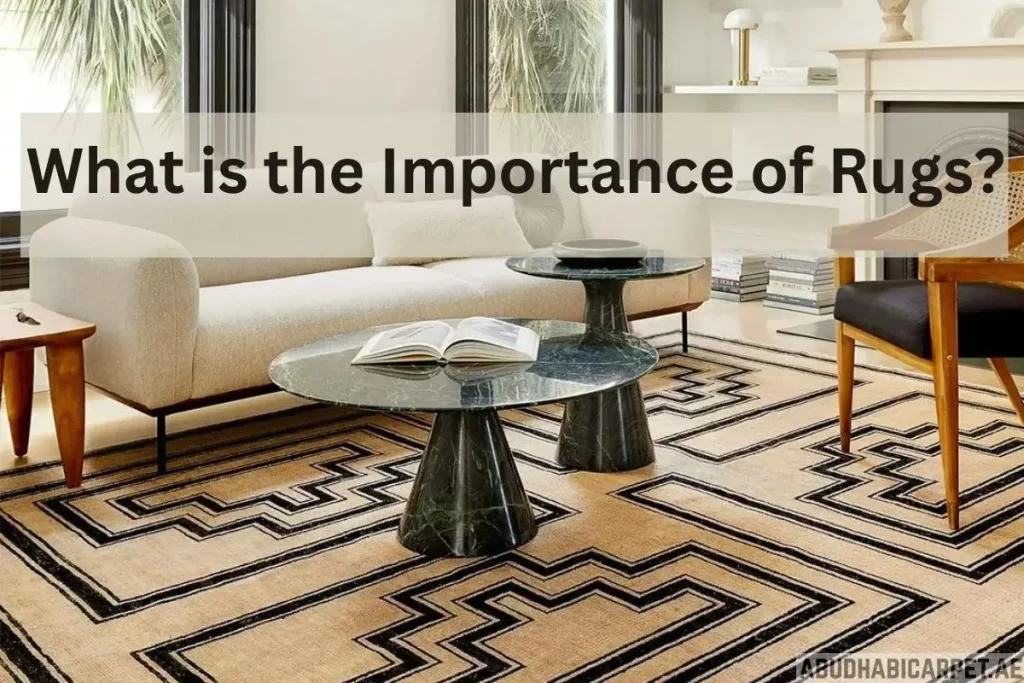What Is The Importance Of Rugs?

Rugs play a pivotal role in enhancing the aesthetics and functionality of living spaces, serving as versatile décor elements with both visual and practical significance. One of the primary importance of rugs lies in their ability to define and anchor a room, tying together various design elements and creating a cohesive atmosphere. They contribute to the overall ambiance by adding warmth, texture, and color, turning a mere space into a comfortable and inviting environment.
Beyond their decorative value, rugs also serve practical purposes. They provide insulation, helping to regulate room temperature and reduce energy costs. Additionally, rugs act as sound absorbers, minimizing echoes and noise within a room, creating a quieter and more peaceful environment. Their soft and cushioned surface also offers comfort underfoot, making them essential in areas where people frequently gather or walk.
Furthermore, rugs can protect the underlying flooring from wear and tear, extending its lifespan. In high-traffic areas, they act as a barrier, preventing scratches and damage. Rugs are not only decorative accents but integral components that contribute to the overall well-being and functionality of a space, making them a valuable investment in interior design.
Types Of Rugs
Rugs come in a diverse array of types, each distinguished by its unique characteristics, materials, and designs. Here are some common types of rugs:
Area Rugs: These versatile rugs are designed to cover specific areas within a room, adding warmth and defining spaces. They come in various shapes, sizes, and patterns.
Persian Rugs: Handcrafted in Iran, Persian rugs are renowned for their intricate designs and high-quality craftsmanship. They often feature elaborate patterns and rich colors.
Oriental Rugs: Originating from various Asian countries, including China and India, Oriental rugs showcase vibrant colors and intricate patterns. They are often made of wool or silk.
Kilim Rugs: Hailing from the Middle East and Central Asia, Kilim rugs are flat-woven, featuring bold geometric patterns and lively colors. They are lightweight and reversible.
Shag Rugs: Known for their plush and high-pile texture, shag rugs add a luxurious and cozy feel to a space. They are popular in bedrooms and living areas.
Runner Rugs: These long, narrow rugs are ideal for hallways, staircases, or narrow spaces. They add a decorative touch while protecting high-traffic areas.
Jute and Sisal Rugs: Made from natural fibers, jute and sisal rugs offer a rustic and organic look. They are durable and eco-friendly, making them popular choices for casual settings.
Braided Rugs: Crafted by intertwining strips of fabric or yarn, braided rugs exude a cozy, homespun charm. They are often associated with traditional and country-style décor.
Moroccan Rugs: Inspired by traditional Moroccan designs, these rugs feature bold geometric patterns and are often made from wool. They add a global and bohemian touch to interiors.
Outdoor Rugs: Specifically designed for outdoor use, these rugs are made from weather-resistant materials like polypropylene, providing both style and durability for patio or deck spaces.
Understanding the various types of rugs allows individuals to choose the one that best suits their aesthetic preferences, functional needs, and the overall design of their living spaces.

Advantages Of Rugs
Rugs offer a myriad of advantages that extend beyond their aesthetic appeal, contributing to both the comfort and functionality of living spaces. Firstly, rugs serve as insulators, providing an additional layer of warmth and helping to regulate room temperature. This insulation effect not only enhances the comfort of a space but also contributes to energy efficiency by reducing heating costs.
Moreover, rugs act as sound absorbers, minimizing echoes and dampening noise within a room. This is particularly beneficial in homes with hard flooring surfaces, creating a quieter and more serene environment. The soft and cushioned surface of rugs also offers a comfortable space for activities such as sitting, playing, or working, especially in areas where furniture is sparse.
In high-traffic areas, rugs act as protective barriers, preserving the underlying flooring from scratches, stains, and wear. This protective function not only extends the lifespan of the floor but also reduces maintenance costs. Additionally, rugs provide a versatile means of transforming the visual appeal of a room, allowing for easy updates to match evolving styles and preferences. Overall, the advantages of rugs encompass both practical and aesthetic aspects, making them indispensable elements in interior design.
Disadvantages Of Rugs
While rugs offer numerous benefits, they also come with certain disadvantages that individuals should consider in their decision-making process. One notable drawback is the potential for allergens and dust mites to accumulate in the fibers of rugs, particularly in homes with individuals prone to allergies. Regular and thorough cleaning is essential to mitigate this issue, requiring additional maintenance efforts.
In high-moisture environments, rugs can become breeding grounds for mold and mildew, posing health risks and necessitating careful moisture control. This is especially relevant in humid climates or areas prone to spills. Additionally, rugs may pose a tripping hazard, especially if they are not properly secured to the floor. This is a concern, particularly for households with young children or elderly individuals.
Cleaning and maintaining rugs can also be time-consuming, requiring vacuuming, spot cleaning, and occasional professional cleaning to preserve their appearance and hygiene. Furthermore, certain types of rugs, such as those made of delicate materials like silk, may be more susceptible to damage and may require extra care.
Are Rugs The Same As Carpets?
Rugs and carpets are similar in that they are both floor coverings made of various materials, but they have some key differences.
A carpet typically refers to a wall-to-wall floor covering that is installed by stretching and taking it to the floor. Carpets are often used to cover an entire room and are commonly found in residential and commercial spaces. They come in a variety of styles, colors, and textures, and are usually installed with the help of professionals.
On the other hand, a rug is a smaller, portable piece of flooring that is often used to cover specific areas within a room. Rugs come in a wide range of sizes, shapes, and designs, and they can be easily moved or replaced. Unlike carpets, rugs are not typically attached to the floor and are more versatile in terms of placement and design.
In summary, while both rugs and carpets serve the purpose of covering and enhancing flooring, the main distinction lies in their size, installation method, and portability. Carpets are usually larger, installed wall-to-wall, and fixed in place, whereas rugs are smaller, movable, and placed strategically within a space.

Importance Of Choosing The Right Rug For Your Space
Selecting the appropriate rug for your living space is a crucial aspect of interior design, as it can significantly impact the overall aesthetic, comfort, and functionality of a room. Here are several reasons highlighting the importance of choosing the right rug for your space:
Enhances Aesthetics: A well-chosen rug can serve as a focal point in a room, tying together various elements of the décor. It adds visual interest, complements color schemes, and contributes to the overall aesthetic appeal of the space
Defines Spaces: Rugs play a vital role in defining different areas within a room, especially in open-concept living spaces. They help create designated zones for activities like dining, lounging, or working, providing a sense of organization and purpose.
Adds Comfort and Warmth: Beyond aesthetics, rugs contribute to the comfort and warmth of a room. They provide a soft surface underfoot, making the space more inviting and cozy. In colder climates, rugs can also act as insulators, offering thermal comfort.
Noise Reduction: Rugs can help dampen sound and reduce echoes in a room, making the environment more acoustically pleasant. This is particularly beneficial in areas with hard flooring surfaces that tend to amplify sound.
Protects Flooring: Placing a rug in high-traffic areas helps protect the underlying flooring from wear and tear. This is especially important in areas like entryways, hallways, and living rooms, where foot traffic is frequent.
Express Personal Style: Rugs come in a wide variety of styles, patterns, and textures, allowing individuals to express their personal style and taste. Whether you prefer a classic, contemporary, or eclectic look, the right rug can be a reflection of your unique aesthetic preferences.
Easy Room Updates: Changing a rug is a relatively simple and cost-effective way to update the look of a room. It allows for seasonal or trend-based adjustments without the need for major renovations.
Allergen Control: Rugs can trap and hold dust and allergens, preventing them from circulating in the air. Regular cleaning of rugs can contribute to a healthier indoor environment, especially for individuals with allergies.
Cohesive Design: When chosen thoughtfully, rugs contribute to a cohesive design scheme. They can tie together disparate elements in a room, such as furniture, wall colors, and accessories, creating a harmonious and well-put-together look.
In conclusion, the right rug is more than just a floor covering; it’s a design element that enhances the overall atmosphere of a space. Considering factors such as size, material, and style when choosing a rug ensures that it not only fits the practical needs of the room but also contributes positively to its visual and tactile appeal.
Conclusion
In conclusion, the selection of the right rug for your living space is a decision that extends far beyond mere aesthetics. Rugs serve as versatile and impactful elements in interior design, offering a myriad of benefits that go well beyond their visual appeal. From defining spaces and adding warmth to providing comfort underfoot and protecting flooring, the importance of choosing the right rug cannot be overstated.
These textile additions are not just floor coverings; they are integral contributors to the overall ambiance of a room. A well-chosen rug can transform a space, creating a harmonious balance between various design elements and reflecting the unique personality of the inhabitants. Whether you opt for the timeless elegance of Oriental rugs, the contemporary flair of modern designs, or the eco-friendly charm of natural fibers, your choice of rug has the power to elevate the entire room.


